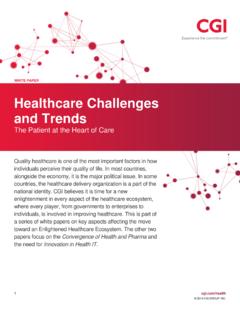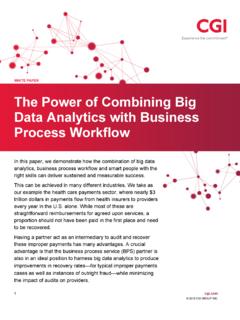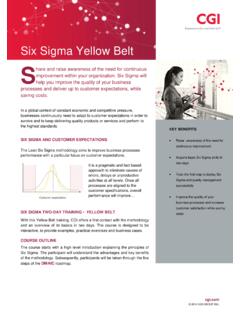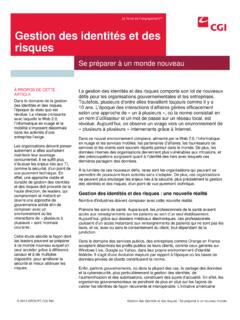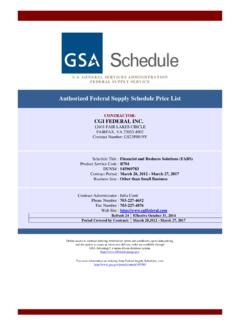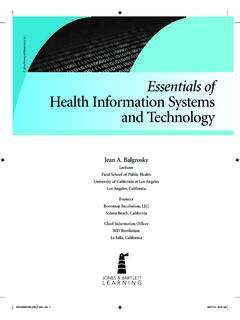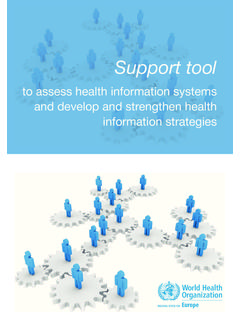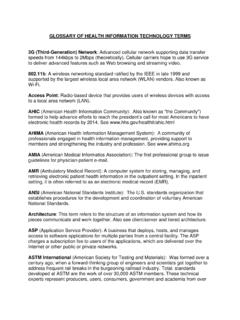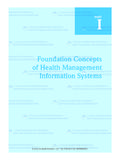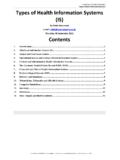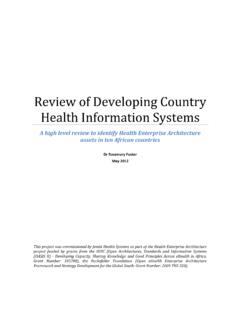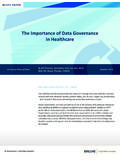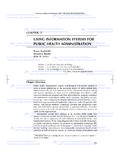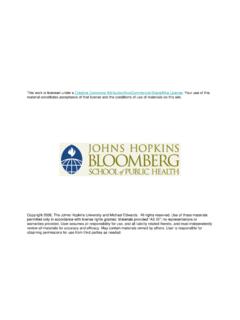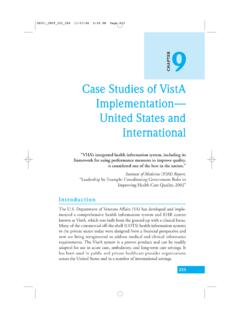Transcription of Health Information Integration: Assessing the …
1 1 2013 CGI GROUP INC. WHITE PAPER Health Information integration : Assessing the Need for integration 2 INTRODUCTION .. 3 Assessing THE NEED FOR integration .. 3 BUSINESS CASE ASSESSMENT .. 3 ORGANIZATIONAL READINESS ASSESSMENT .. 4 BUSINESS PROCESS ASSESSMENT .. 4 TECHNOLOGY ASSESSMENT .. 4 FINDING THE EVIDENCE .. 5 ANALYZING THE EVIDENCE .. 6 KEY HIIF SUCCESS FACTORS .. 7 INTEROPERABILITY .. 7 DATA ANALYTICS .. 8 ORGANIZATIONAL CHANGE MANAGEMENT .. 8 BARRIERS TO HIIF SUCCESS .. 8 RECOMMENDATIONS BASED ON THE EVIDENCE .. 9 BUSINESS CASE .. 9 ORGANIZATIONAL READINESS .. 9 BUSINESS PROCESSES .. 9 TECHNOLOGY .. 10 NEXT STEPS .. 10 APPENDIX .. 11 LITERATURE REVIEW REFERENCE LIST .. 11 WHITE PAPER REFERENCE LIST .. 11 3 Software developers rarely consider security unless they are forced to do so.
2 Therefore, it is critical for enterprises that develop solutions in-house to conduct regular training on good security practices and conduct reviews of the security design of solutions before they are deployed. Software developers rarely consider security unless they are forced to do so. Therefore, it is critical for enterprises that develop solutions in-house to conduct regular training on good security practices and conduct reviews of the security design of solutions before they are deployed. Software developers rarely consider security unless they are forced to do so. Therefore, it is critical for enterprises that develop solutions in-house to conduct regular training on good security practices and conduct reviews of the security design of solutions before they are deployed.
3 Introduction This paper is the second in a series on Health Information integration . The first paper An Introduction to Health Information integration discussed a Health care organization s need for a method to manage the many variables involved in developing interoperable Health care systems and highlighted CGI s Health Information integration Framework (HIIF) as such a method. This second paper compares the results of an academic literature review with the assessment concepts and processes encompassed in HIIFs. The literature review was conducted to examine Health Information integration from a patient care and safety perspective and to evaluate the need for an HIIF within the current Health care environment. The review demonstrates the value of HIIF components when applied to real problems facing Health care organizations today and why an IT framework should be considered within the context of Health care delivery.
4 Assessing the need for integration A proper assessment of an organization s readiness and capabilities is required to establish a sound planning foundation for Health Information integration . CGI s HIIF is based on a standard cycle of organizational planning and effort. It brings both technical and business planning and execution together, creating the necessary alignment for successful Health Information integration initiatives. CGI s HIIF provides Health care organizations with a way to evaluate, prepare, implement and support a new Information sharing reality by applying a flexible yet structured approach to Information integration . It s based on five key phases: assessment, gap analysis, solution development, implementation and steady state.
5 This paper focuses on the first phase assessment. Assessment ensures that constraints are identified and respected and that strengths and reusable assets are leveraged. It centers around four main categories: business case, organizational readiness, business processes and technology. BUSINESS CASE ASSESSMENT A business case assessment is performed to ensure that a cost-benefit analysis, risk identification, preliminary business requirements, and known fiscal and resource constraints are part of the planning. Without a strong and focused business case, complicated integration efforts will fall prey to the many competing interests in an organization s technical and business operations. A proper assessment of an organization s readiness and capabilities is required to create a sound planning foundation for Health Information integration .
6 Business Requirements Fiscal and Resource Risk Envisioned Future State Business Case 4 ORGANIZATIONAL READINESS ASSESSMENT An organizational readiness assessment is performed to determine whether an organization s current structure and culture support the required changes/enhancements for Health Information integration . This includes Assessing the organization s governance structure and determining whether its covers key elements, such as data ownership, data stewardship and data governance. An organization s overall readiness for change is imperative for Information integration initiatives to generate their intended results. BUSINESS PROCESS ASSESSMENT An assessment of the current function, purpose, reliability, specificity, maturity and predicted longevity of business and clinical processes is performed to determine the nature and extent of required changes/enhancements.
7 This assessment determines what business and clinical processes must remain intact despite technological changes/enhancements and, on the other hand, what processes will need to change to support the goals and objectives related to Information integration . TECHNOLOGY ASSESSMENT An assessment of technology services, platforms and applications is performed to determine the following: (i) the nature and extent of changes/enhancements An organization s overall readiness for change is imperative for Information integration initiatives to generate their intended results. Business Processes Administrative Processes Clinical Processes Governance Organizational Change Management Related and Competing Initiatives Organizational Readiness 5 required; (ii) any reusable assets available; and (iii) service, program and enterprise architecture strengths and challenges.
8 These four types of assessments serve as building blocks that form the foundation for successful Health Information integration . Without them, an HIIF lacks a proper baseline for success. Finding the evidence The above mentioned literature review was undertaken to evaluate available academic evidence supporting the use of an HIIF in Information integration initiatives. It examined what is currently being done in the industry by asking a specific question about the potential benefits of Health Information integration : Do fewer patient safety incidents or fewer readmissions occur when patients are admitted to a hospital that uses an integrated Information solution compared to a hospital that uses an electronic Health record alone? Search criteria were researched and developed for the literature review and then used to search a number of databases.
9 A search matrix was used to search PubMed, EBSCO, British Nursing Index, ABI Inform/Complete, British Nursing Index with Full Text, Allied & Complementary Medicine , Gale Group Health Periodicals Database, and MEDLINE . A public domain search was also conducted using Google Scholar. Articles relevant to the topic were selected for inclusion in the literature review and were critically appraised. In the end, a total of 17 articles that met the author s inclusion criteria were selected for review. A method was devised for rating the articles based on the strength of the evidence they presented. Peer reviewed articles were scored out of eight points while non-peer reviewed articles were scored out of seven points. Peer reviewed and non-peer reviewed articles scoring greater than four points were used to develop recommendations.
10 Of the 17 initial articles, recommendations were based on five articles scoring greater than four. These articles are listed in the literature review reference list at the end of this paper. More details about the search strategy and ranking method used can be obtained by contacting the author. These four types of assessments serve as building blocks that form the foundation for successful Health Information integration . Architecture Applications Services Infrastructure Technology 6 Analyzing the evidence In response to the research question posed in the Finding the evidence section above, industry assumptions about improved patient care and safety resulting from Health Information integration are not fully supported by the evidence.
